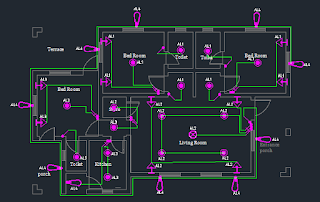LESSON 3
PROJECT 1
You might be wondering how to go about calculating the number of fittings for each room
The
formula used is given as:
N =(E * A)/(Ø * UF * MF)
Where:
Ø: is the luminous flux emitted by the lamp chosen and its value is provided by
the Manufacturer;
N: is the number of required lamp
E: is the illuminance level chosen based on IESNA recommendations;
A: is the area of the space to be lit;
M.F: is the maintenance factor (given by the lamp manufacturer usually 0.8 - 0.9 );
U.F: is the coefficient of utilization (is a ratio of utilized flux to the total
flux emitted and is determined
by the lighting scheme adopted, given by the luminaire manufacturer in their
photometric data after calculating the room index).

